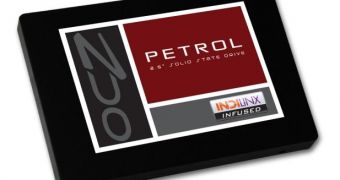Although flash manufacturers like Intel or Samsung are not happy with this, NAND flash prices keep on falling and SSDs are becoming more affordable by the week. OCZ’s Petrol SSD has just been listed for just 0.5 EUR per GB and that’s quite close to our own prediction of 0.4 USD per GB.
The particulars of this offer may be related to OCZ’s latest SSD launches and the ones that will soon follow this summer, but the thing is that the factory gate price is likely lower.
OCZ’s Petrol uses Marvell’s controller with OCZ’s own Indilinx firmware platform. This allows the drive to achieve quite decent performance of sequential read and write speeds up to 370 MB/s and 250MB/s, respectively.
While not being as impressive as SandForce’s theoretical 500 MB/s performance, OCZ’s Petrol likely offers much more stable and uniform performance.
SandForce-based drives can surprise users with much lower speeds than the theoretical specifications.
In our own experience, we discovered SandForce 2281-based SSDs that only got 180 to 200 MB/s in sequential read speeds on a 128 GB SSD with 40% of the drive occupied with the operating system and programs.
The controllers from Marvell along with OCZ’s Indilinx firmware platform will likely offer better performance despite the fact that, unlike the OCZ Octane, this SSD uses asynchronous NAND flash memory.
As SSD prices are falling rapidly, we’re starting to understand why Western Digital and Seagate are ripping us off and buying almost every other HDD manufacturer in the world.
The two real HDD companies left are milking the HDD “crisis” pretext for some more billions, as they know people will soon give up on HDD for a while, until the prices go down.
On the other hand, if the HDD prices are not getting back to normal, the greatly increased demand for SSDs will make the SSD market more profitable, and we can see significant expansion of NAND manufacturing capacity being announced soon.

 14 DAY TRIAL //
14 DAY TRIAL //